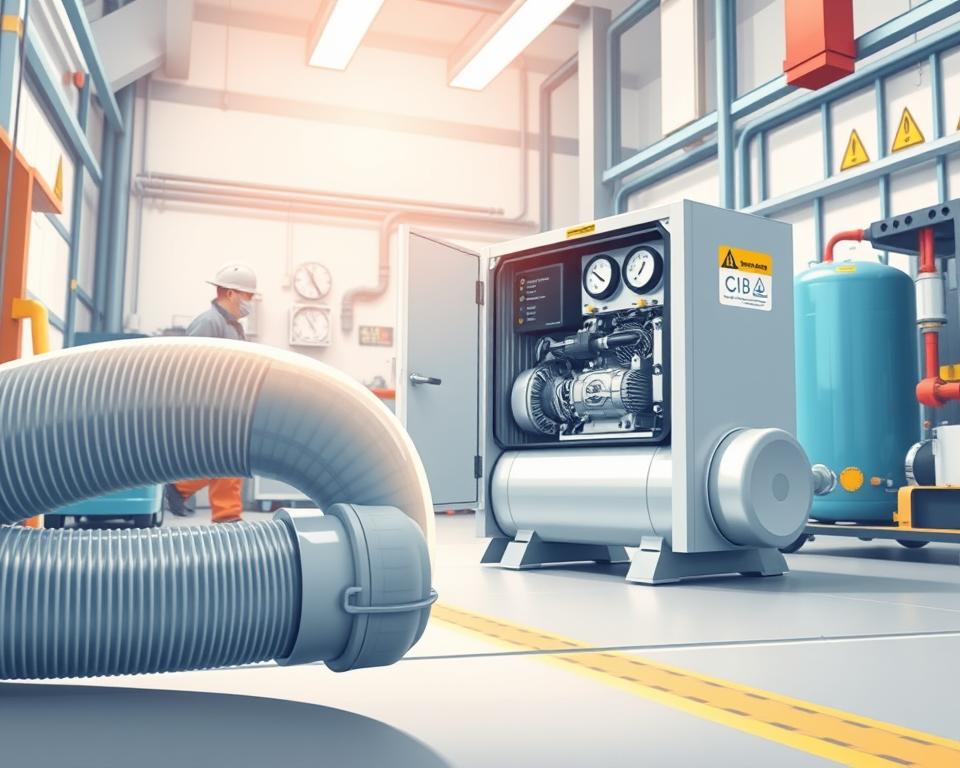Your Complete Guide to PVC Pipe in Compressed Air Systems
Did you know that a ruptured compressed air system can release energy equivalent to a stick of dynamite? Countless operations remain oblivious to the risks of certain piping systems they employ. Read on to discover why PVC for air lines choices demand top-tier safety.
Although some plastics gain popularity, OSHA flatly forbids their above-ground application. Oil contact and repeated temperature swings degrade these pipes, risking sudden ruptures. Even at “safe” pressure ratings, the risk of explosions remains high.
Turn to Installation Parts Supply for sturdy aluminum systems. Spending on the right materials prevents OSHA penalties and protects employees. Here’s how to assemble a risk-free system.

Central Ideas
- Explosion danger leads OSHA to outlaw some pipe materials.
- Pressure ratings drop as temperatures fluctuate.
- Long-term exposure makes pipes prone to brittle breaks.
- Aluminum lines deliver a far safer option.
- Invest wisely to dodge fines and protect staff.
Why You Shouldn’t Use PVC for Compressed Air
Manufacturers explicitly warn against using some plastics for high-energy applications. A breach in a pressurized air line unleashes explosive power, unlike water. Select your piping wisely to avoid deadly failures.
- Brittleness: Below-freezing conditions render PVC dangerously brittle.
- Adhesive failures: Oil contamination and heat cycles break down glue bonds.
- Misleading ratings: Most shops run above 110°F, slashing rated pressure in two.
A facility faced a $110k penalty when PVC shattered and harmed employees. The “heat of compression” further reduces safe operating limits, a factor often overlooked in ratings.
“Above-ground use of certain plastics for compressed air violates OSHA standards due to explosion risks.”
Metal alternatives fail more predictably, bending rather than fragmenting. Plastic shrapnel from explosive failures can travel over 50 feet, embedding in walls or equipment.
Daily heat and cold cycles in a workshop degrade plastics rapidly. A decade’s UV and chemical attack weakens plastic, so small leaks too often balloon into disasters.
Best Materials Instead of PVC for Air Lines
Aluminum piping systems outperform traditional options in both safety and efficiency. Black pipe vs. aluminum: aluminum wins with 90% fewer leaks. Their lightweight design and corrosion resistance make them ideal for long-term use.
Modular aluminum setups save time—no threading required. Installation Parts Supply offers pre-assembled sections that snap together. A Midwest auto plant cut labor costs by 40% after switching to this system.
- Copper: Copper’s antimicrobial action suits it to cleanroom air lines. Requires soldering expertise.
- Stainless Steel: In seaside shops, stainless steel won’t corrode.
- ABS/HDPE: For solvent-rich environments, ABS/HDPE stays intact.
“Our aluminum retrofit reduced energy waste by 15%—paying for itself in 18 months.”
Don’t ignore torque specs. Too tight splits fittings; too loose lets air escape. Stick to recommended 25–30 ft-lb torque for aluminum.
Use NSF-certified materials when air quality is critical. Choose pipe rated for your specific operating environment.
How to Choose the Right Piping Material for Your Needs
Balance budget, safety, and performance when choosing pipe. A Midwest factory saved $12,000 annually by switching to leak-resistant aluminum. Use this guide to select the optimal material.
| Material | Cost (per ft) | Maintenance | ROI Time |
|---|---|---|---|
| Aluminum | $8.50 | Low | 18 months |
| Black Pipe | $5.00 | High | N/A |
| Copper | $10.20 | Medium | 24 months |
Don’t ignore thermal limits. Aluminum handles -40°F to 200°F, while plastics crack below freezing. Stainless steel stands up to harsh chemicals.
Pro Tip: Compute ROI based on compressed-air leakage. A 10% leak in a 50 HP system wastes $3,500 yearly.
- Ensure your pipe PSI rating exceeds system pressure.
- Check OSHA compliance for weld inspections and pressure tests.
- Get a complimentary piping audit from Installation Parts Supply.
“Our aluminum retrofit cut energy waste by 15%—paying for itself in 18 months.”
DIY installations work for small shops, but professionals ensure leak-free joints. Don’t forget to read the fine print on warranty lengths.
The Bottom Line
Safety outweighs sticker price in compressed-air piping. Older systems account for 92% of accidents due to degraded piping. Pick aluminum for near-perfect reliability.
Don’t forget:
- Avoid brittle materials that shatter under pressure.
- Metallic lines beat plastics on both safety and durability.
- Ignoring standards invites fines and insurance headaches.
Ready to upgrade? Grab same-day pricing and deals on kits from Installation Parts Supply. Download our free maintenance template or call for emergency replacements.
Invest in secure lines now to protect your crew.